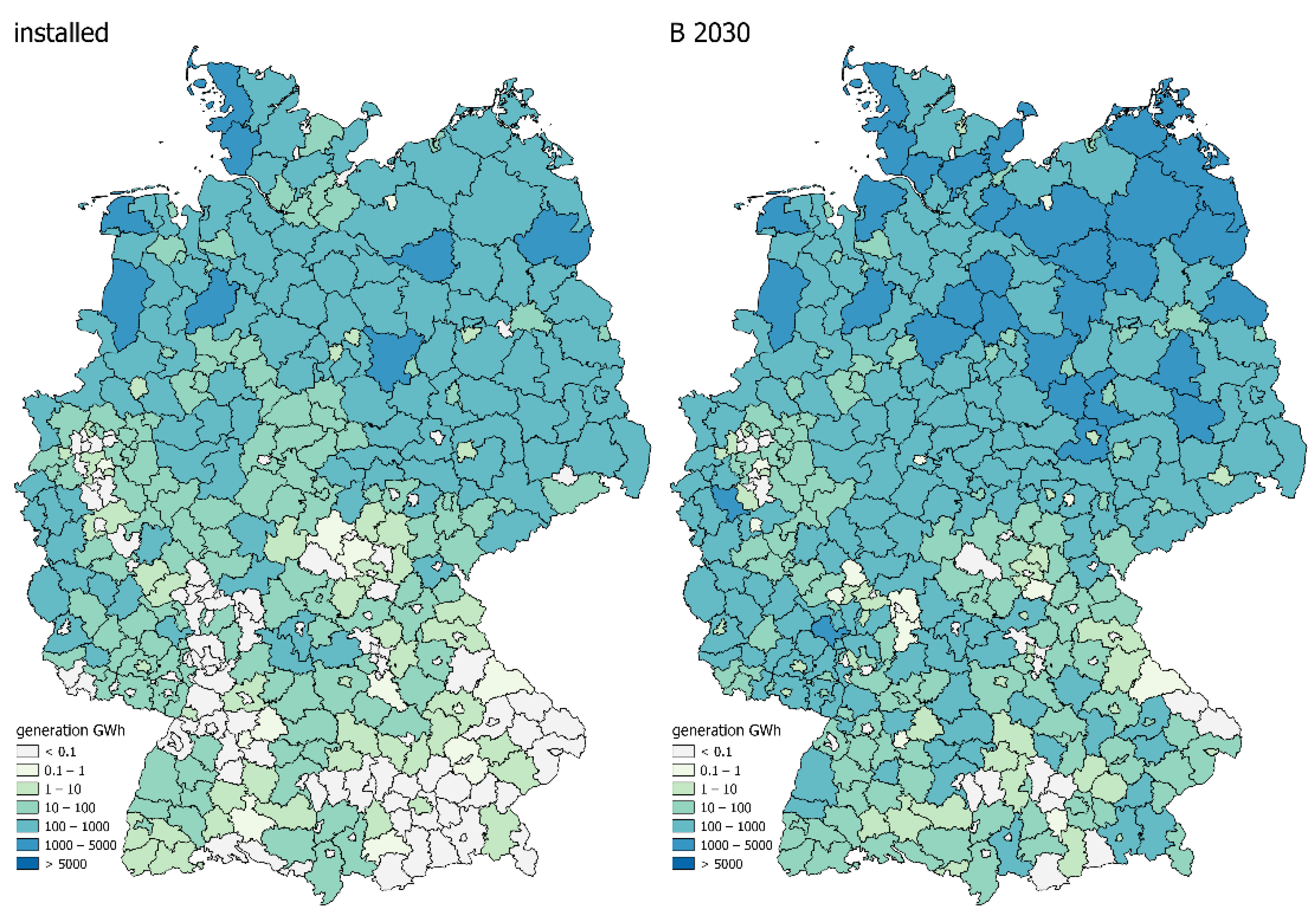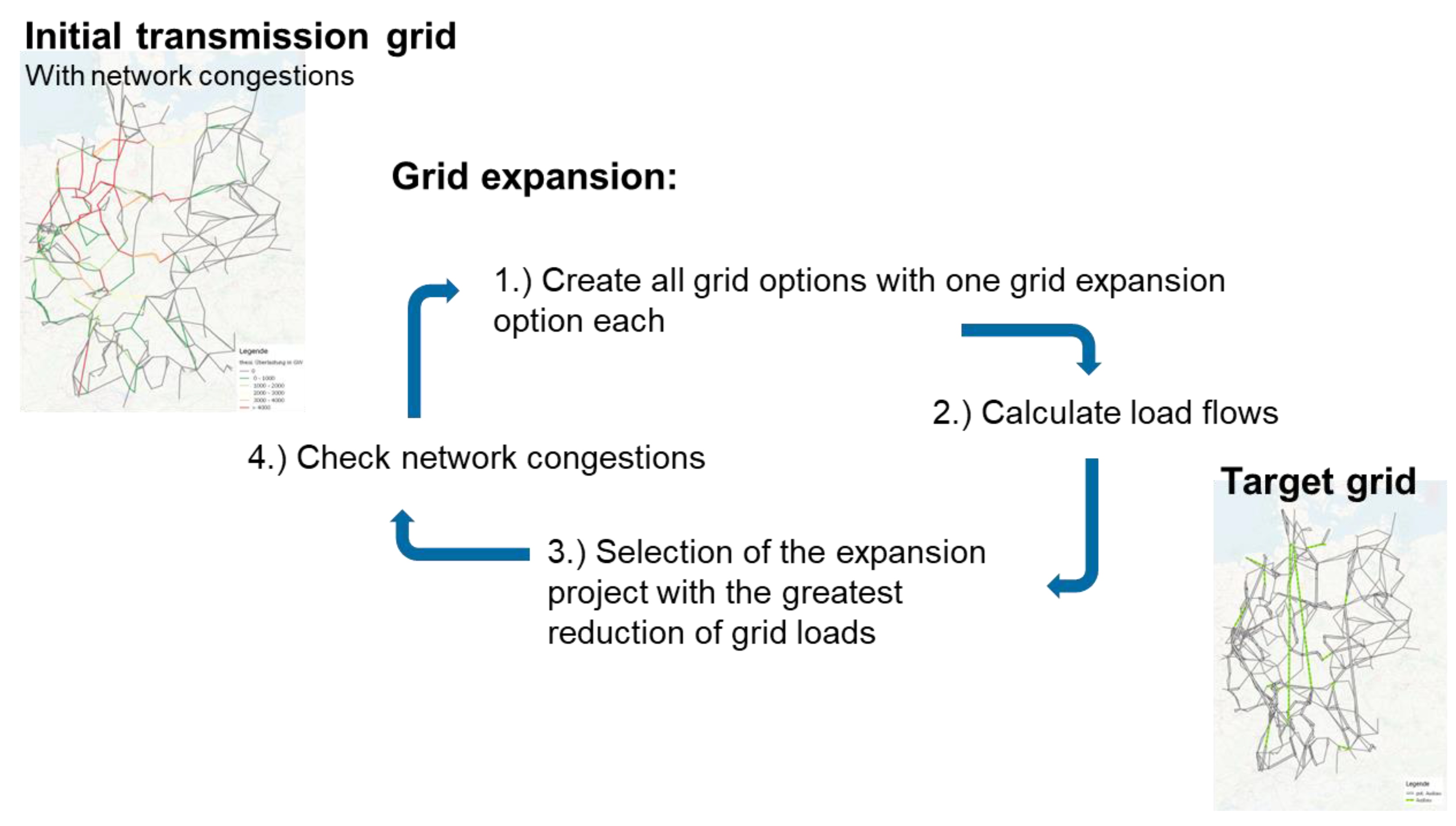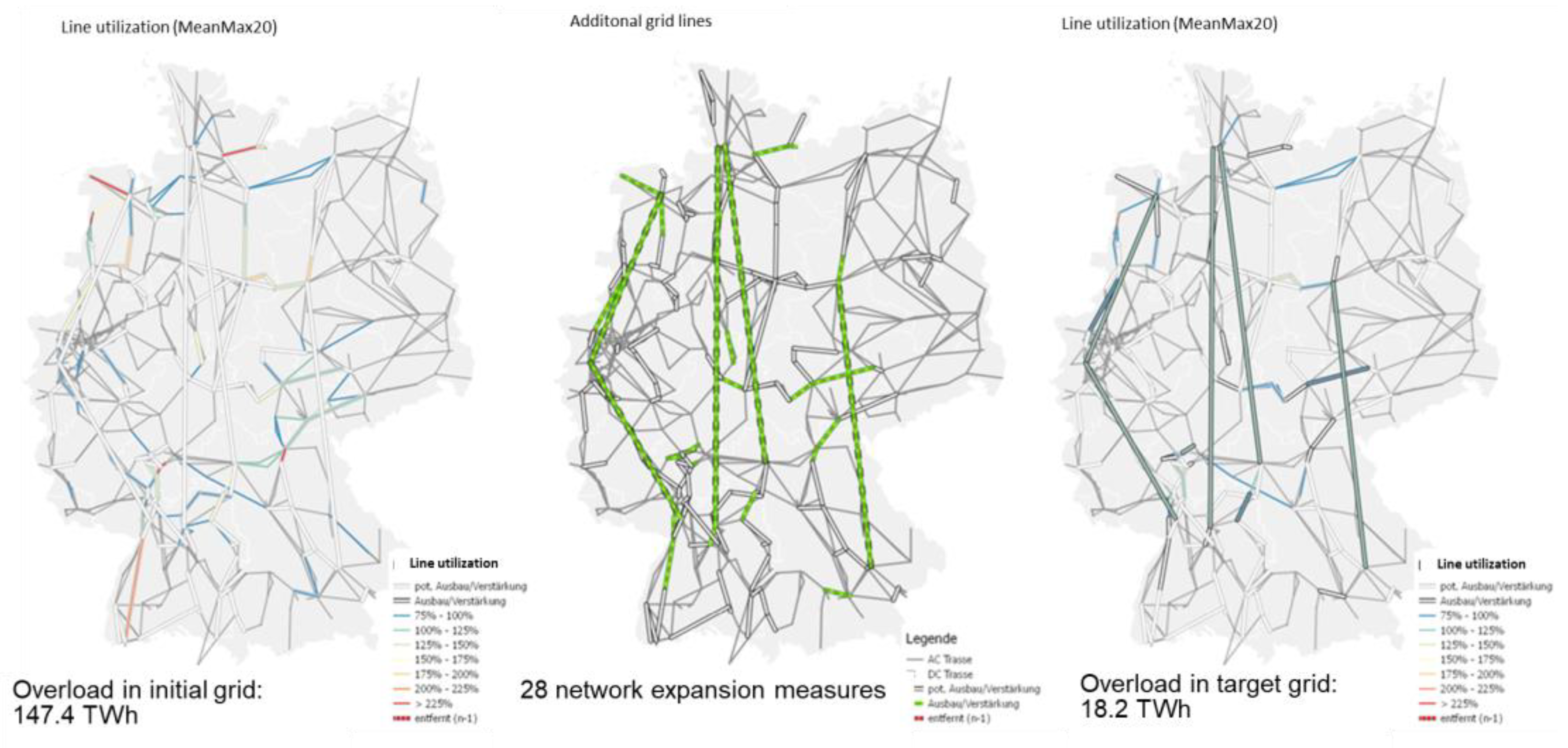Addressing the Effect of Social Acceptance on the Distribution of Wind Energy Plants and the Transmission Grid in Germany
Abstract
:1. Introduction
2. Methodology and Data
2.1. Wind Distribution Scenarios
2.2. Market Dispatch
- Step 1: Local dispatch at the level of governmental districts, excluding large power plants with more than 150 MW electrical capacity and oil-fired power plants. There is no electrical interconnection between governmental districts.
- Step 2: Local dispatch at the level of federal states, based on power plant and storage dispatch from step 1 as minimum restriction. There is no electrical interconnection between federal states. Furthermore, a CO2-emission cap of 120 million tons for the German electricity sector must be considered.
- Step 3: European-wide dispatch based on power plant and storage dispatch from step 2 as minimum restriction. Furthermore, a CO2-emission cap of 120 million tons for the German electricity sector has to be considered.
2.3. Grid Expansion Need
- how many grid expansion projects need to be implemented to solve existing thermal congestions;
- to what extent the variation of scenario assumptions influences the transmission grid expansion need;
- which specific grid expansion projects of the defined pool grid development measures are needed, independent of the chosen scenario.
3. Results
- The calculation of the load flow is simplified. It is assumed that there is no voltage drop between two substations and that the active resistance of a line is significantly lower than the reactance, so that no line losses occur and no reactive power must be transported.
- The termination criterion of the iterative network expansion focuses on the aggregated annual overload of all individual lines. An analysis of the remaining maximum line overloads is then performed. The NEP does not provide an exact indication of the termination criterion used to determine the need for network expansion [52].
- To determine the complete network expansion requirement, an (n-1) analysis should be performed after the thermal overloads have been eliminated.
- The starting network differs from the NEP. Due to the path dependency this can lead to different results.
3.1. Economic Scenario-Grid Expansion Need
3.2. Socio-Ecologic Scenario-Grid Expansion Need
- With regard to the network expansion requirement identified by means of the iterative network expansion, the evenly distributed socio-ecologic scenario with the requirement for 23 lines or 2547 line kilometers has a slightly lower network expansion requirement than the economic scenario (28 network expansion projects, 2833 line kilometers).
- The equal distribution of wind-onshore plants regarding the criterion “degree of load” thus leads to an approximately 10% lower network expansion requirement than an economically optimized distribution of wind-onshore plants.
- The remaining maximum overloads of individual lines are largely comparable in the own target networks.
3.3. Decentralized Scenario-Grid Expansion Need
4. Discussion
5. Conclusions
Author Contributions
Funding
Institutional Review Board Statement
Informed Consent Statement
Data Availability Statement
Acknowledgments
Conflicts of Interest
References
- Lund, H.; Mathiesen, B.V. Energy system analysis of 100% renewable energy systems—The case of Denmark in years 2030 and 2050. Energy 2009, 34, 524–531. [Google Scholar] [CrossRef]
- Bundesregierung, D. Bilanz zur Energiewende. Berlin. 2015. Available online: https://www.bundesregierung.de/resource/blob/974430/438096/18fd7dc41876b13597a1fd151c186cb9/2015-03-23-bilanz-energiewende-2015-data.pdf?download=1 (accessed on 6 August 2021).
- Ommen, T.; Markussen, W.B.; Elmegaard, B. Comparison of linear, mixed integer and non-linear programming methods in energy system dispatch modelling. Energy 2014, 74, 109–118. [Google Scholar] [CrossRef]
- Baños, R.; Manzano-Agugliaro, F.; Montoya, F.G.; Gil, C.; Alcayde, A.; Gómez, J. Optimization methods applied to renewable and sustainable energy: A review. Renew. Sustain. Energy Rev. 2011, 15, 1753–1766. [Google Scholar] [CrossRef]
- Jebaraj, S.; Iniyan, S. A review of energy models. Renew. Sustain. Energy Rev. 2006, 10, 281–311. [Google Scholar] [CrossRef]
- Bale, C.S.E.; Varga, L.; Foxon, T.J. Energy and complexity: New ways forward. Appl. Energy 2015, 138, 150–159. [Google Scholar] [CrossRef] [Green Version]
- Pfenninger, S.; Hirth, L.; Schlecht, I.; Schmid, E.; Wiese, F.; Brown, T.; Davis, C.; Gidden, M.; Heinrichs, H.; Heuberger, C.; et al. Opening the black box of energy modelling: Strategies and lessons learned. Energy Strategy Rev. 2018, 19, 63–71. [Google Scholar] [CrossRef]
- Pfenninger, S.; Hawkes, A.; Keirstead, J. Energy systems modeling for twenty-first century energy challenges. Renew. Sustain. Energy Rev. 2014, 33, 74–86. [Google Scholar] [CrossRef]
- Lopion, P.; Markewitz, P.; Robinius, M.; Stolten, D. A review of current challenges and trends in energy systems modeling. Renew. Sustain. Energy Rev. 2018, 96, 156–166. [Google Scholar] [CrossRef]
- Hausl, S.; Biberacher, M. Räumliche Aspekte in der regionalen Energiesystemoptimierung. In Geoinformationssysteme. Beiträge zum 17. Münchner Fortbildungsseminar 2012; Wichmann: Karlsruhe, Germany, 2012; pp. 290–305. [Google Scholar]
- Hanson, B.; Sugden, A.; Alberts, B. Making Data Maximally Available. Science 2011, 331, 649. [Google Scholar] [CrossRef] [Green Version]
- DeCarolis, J.F.; Babaee, S.; Li, B.; Kanungo, S. Modelling to generate alternatives with an energy system optimization model. Environ. Model. Softw. 2016, 79, 300–310. [Google Scholar] [CrossRef] [Green Version]
- Fehr, J.; Heiland, J.; Himpe, C.; Saak, J. Best practices for replicability, reproducibility and reusability of computer-based experiments exemplified by model reduction software. AIMS Math. 2016, 1, 261–281. [Google Scholar] [CrossRef]
- Mai, T.; Logan, J.; Blair, N.; Sullivan, P.; Bazilian, M. RE-ASSUME—A Decision Maker’s Guide to Evaluating Energy Scenarios, Modeling, and Assumptions. 2013. Available online: http://iea-retd.org/wp-content/uploads/2013/07/RE-ASSUME_IEA-RETD_2013.pdf (accessed on 6 August 2021).
- Sovacool, B.K. What are we doing here? Analyzing fifteen years of energy scholarship and proposing a social science research agenda. Energy Res. Soc. Sci. 2014, 1, 1–29. [Google Scholar] [CrossRef]
- Enevoldsen, P.; Sovacool, B.K. Examining the social acceptance of wind energy: Practical guidelines for onshore wind project development in France. Renew. Sustain. Energy Rev. 2016, 53, 178–184. [Google Scholar] [CrossRef]
- Wüstenhagen, R.; Wolsink, M.; Bürer, M.J. Social acceptance of renewable energy innovation: An introduction to the concept. Energy Policy 2007, 35, 2683–2691. [Google Scholar] [CrossRef] [Green Version]
- AEE. Akzeptanzumfrage 2015: Die deutsche Bevölkerung will mehr Erneuerbare Energien. 2015. Available online: https://www.unendlich-viel-energie.de/media/file/416.AEE_RenewsKompakt_Akzeptanzumfrage2015.pdf (accessed on 6 August 2021).
- Sovacool, B.K. Energy studies need social science. Nature 2014, 511, 529–530. [Google Scholar] [CrossRef]
- Börjeson, L.; Höjer, M.; Dreborg, K.-H.; Ekvall, T.; Finnveden, G. Scenario types and techniques: Towards a user’s guide. Futures 2006, 38, 723–739. [Google Scholar] [CrossRef]
- Dieckhoff, C.; Eberspächer, A. Consulting with Energy Scenarios—Requirements for Scientific Policy Advice. 2016. Available online: https://www.researchgate.net/publication/298208270_Consulting_with_energy_scenarios_Requirements_for_scientific_policy_advice/link/56e6c77008ae65dd4cc1cf5e/download (accessed on 6 August 2021).
- acatech. Mit Energieszenarien gut Beraten. Anforderungen an Wissenschaftliche Politikberatung. 2015. Available online: https://www.leopoldina.org/uploads/tx_leopublication/2015_12_Stellungnahme_Energieszenarien.pdf (accessed on 6 August 2021).
- Varho, V.; Tapio, P. Combining the qualitative and quantitative with the Q2 scenario technique—The case of transport and climate. Technol. Forecast. Soc. Chang. 2013, 80, 611–630. [Google Scholar] [CrossRef]
- Dieckhoff, C.; Appelrath, H.-J.; Fischedick, M.; Grunwald, A.; Höffler, F.; Mayer, C.; Weimer-Jehle, W. Zur Interpretation von Energieszenarien (Schriftenreihe Energiesysteme der Zukunft), München. 2014. Available online: http://www.leopoldina.org/uploads/tx_leopublication/2014_ESYS_Energieszenarien.pdf (accessed on 6 August 2021).
- Schubert, D.K.J.; Thuß, S.; Möst, D. Does political and social feasibility matter in energy scenarios? Energy Res. Soc. Sci. 2015, 7, 43–54. [Google Scholar] [CrossRef]
- Söderholm, P.; Hildingsson, R.; Johansson, B.; Khan, J.; Wilhelmsson, F. Governing the transition to low-carbon futures: A critical survey of energy scenarios for 2050. Futures 2011, 43, 1105–1116. [Google Scholar] [CrossRef]
- Laugs, G.A.H.; Moll, H.C. A review of the bandwidth and environmental discourses of future energy scenarios: Shades of green and gray. Renew. Sustain. Energy Rev. 2017, 67, 520–530. [Google Scholar] [CrossRef]
- Jefferson, M. Closing the gap between energy research and modelling, the social sciences, and modern realities. Energy Res. Soc. Sci. 2014, 4, 42–52. [Google Scholar] [CrossRef]
- Trutnevyte, E.; Stauffacher, M.; Schlegel, M.; Scholz, R.W. Context-Specific Energy Strategies: Coupling Energy System Visions with Feasible Implementation Scenarios. Environ. Sci. Technol. 2012, 46, 9240–9248. [Google Scholar] [CrossRef]
- Hughes, N.; Strachan, N.; Gross, R. The structure of uncertainty in future low carbon pathways. Energy Policy 2013, 52, 45–54. [Google Scholar] [CrossRef]
- Fragnière, E.; Kanala, R.; Moresino, F.; Reveiu, A.; Smeureanu, I. Coupling techno-economic energy models with behavioral approaches. Oper. Res. 2017, 17, 633–647. [Google Scholar] [CrossRef] [Green Version]
- Weimer-Jehle, W. Cross-impact balances: A system-theoretical approach to cross-impact analysis. Technol. Forecast. Soc. Chang. 2006, 73, 334–361. [Google Scholar] [CrossRef]
- Fortes, P.; Alvarenga, A.; Seixas, J.; Rodrigues, S. Long-term energy scenarios: Bridging the gap between socio-economic storylines and energy modeling. Technol. Forecast. Soc. Chang. 2014, 91, 161–178. [Google Scholar] [CrossRef]
- Aitken, M. Why we still don’t understand the social aspects of wind power: A critique of key assumptions within the literature. Energy Policy 2010, 38, 1834–1841. [Google Scholar] [CrossRef]
- Fink, S.; Bartels, J.-E.; Hagendorf, W.; Klinger, N. Determinants of subnational party positions on electricity grid expansion in Germany: Economic over political interests. Util. Policy 2019, 58, 145–157. [Google Scholar] [CrossRef]
- Schmid, E.; Knopf, B.; Pechan, A. Putting an energy system transformation into practice: The case of the German Energiewende. Energy Res. Soc. Sci. 2016, 11, 263–275. [Google Scholar] [CrossRef]
- Lilliestam, J.; Hanger, S. Shades of green: Centralisation, decentralisation and controversy among European renewable electricity visions. Energy Res. Soc. Sci. 2016, 17, 20–29. [Google Scholar] [CrossRef] [Green Version]
- Bauknecht, D.; Funcke, S.; Vogel, M. Is small beautiful? A framework for assessing decentralised electricity systems. Renew. Sustain. Energy Rev. 2020, 118, 109543. [Google Scholar] [CrossRef]
- Senkpiel, C.; Shammugam, S.; Biener, W.; Hussein, N.S.; Kost, C.; Kreifels, N.; Hauser, W. Concept of evaluating chances and risks of grid autarky. In Proceedings of the 13th INternational Conference on the European Energy Market (EEM), Porto, Portugal, 6–9 June 2016; pp. 1–5. [Google Scholar] [CrossRef]
- Tröndle, T.; Pfenninger, S.; Lilliestam, J. Home-made or imported: On the possibility for renewable electricity autarky on all scales in Europe. Energy Strategy Rev. 2019, 26, 100388. [Google Scholar] [CrossRef]
- Timpe, C.; Bauknecht, D.; Flachsbarth, F.; Koch, M. Transparenz Stromnetze-Szenarienbericht. 2017. Available online: https://www.transparenz-stromnetze.de/fileadmin/downloads/Oeko-Institut__2018__Ergebnisbericht_Szenarien.pdf (accessed on 6 August 2021).
- Timpe, C.; Bauknecht, D.; Flachsbarth, F.; Koch, M. Transparenz Stromnetze-Stakeholder-Diskurs und Modellierung zum Netzausbau und Alternativen. 2018. Available online: https://www.transparenz-stromnetze.de/fileadmin/downloads/Oeko-Institut_2018_Transparenz_Stromnetze.pdf (accessed on 6 August 2021).
- Degel, M.; Christ, M.; Grünert, J.; Becker, L.; Wingenbach, C.; Soethe, M.; Bunke, W.-D.; Mester, K.; Wiese, F. VerNetzen: Sozial-ökologische und Technisch-Ökonomische Modellierung von Entwicklungspfaden der Energiewende; Projektabschlussbericht. 2016. Available online: http://www.uni-flensburg.de/fileadmin/content/abteilungen/industrial/dokumente/downloads/veroeffentlichungen/forschungsergebnisse/vernetzen-2016-endbericht-online.pdf (accessed on 6 August 2021).
- Koch, M.; Flachsbarth, F.; Winger, C.; Timpe, C.; Christ, M.; Söthe, M.; Wingenbach, C.; Hilpert, S.; Degel, M.; Brummer, V.; et al. Perspektiven der Bürgerbeteiligung an der Energiewende unter Berücksichtigung von Verteilungsfragen: Modul 3: Berücksichtigung Gesellschaftlicher Faktoren bei der Entwicklung der Stromnetze. 2018. Available online: https://www.oeko.de/fileadmin/oekodoc/Endbericht-BuergEn-Stromnetze.pdf (accessed on 6 August 2021).
- 50Hertz Transmission GmbH; Amprion GmbH; TenneT TSO GmbH; TransnetBW GmbH. Netzentwicklungsplan Strom 2030, Version 2017. 2016. Available online: https://www.netzentwicklungsplan.de/sites/default/files/paragraphs-files/NEP_2030_1_Entwurf_Teil1_0.pdf (accessed on 6 August 2021).
- Becker, S.; Bues, A.; Neumann, M. Die Analyse Lokaler Energiepolitischer Konflikte und das Entstehen Neuer Organisationsformen: Theoretische Zugänge und Aktuelle Herausforsderungen. EnerLOG Working Paper, Erkner/Freiburg/Potsdam: Leibniz-Institut für Regionalentwicklung und Strukturplanung/Local Governments for Sustainability/ZukunftsAgentur Brandenburg. 2014. Available online: https://www.researchgate.net/publication/289523454_Die_Analyse_lokaler_energiepolitischer_Konflikte_und_das_Entstehen_neuer_Organisationsformen_Theoretische_Zugange_und_aktuelle_Herausforderungen/link/568e637f08ae78cc0515e21e/download (accessed on 6 August 2021).
- Wingenbach, M. Integration Sozial-Ökologischer Faktoren in die Energiesystemmodellierung am Beispiel von Entwicklungspfaden für den Windenergieausbau in Deutschland. Ph.D. Dissertation, Europa-Universität Flensburg, Flensburg, Germany, 2018. Available online: https://www.zhb-flensburg.de/dissert/wingenbach/ (accessed on 6 August 2021).
- Christ, M.; Soethe, M.; Degel, M.; Wingenbach, C. Wind energy scenarios for the simulation of the German power system until 2050: The effect of social and ecological factors: IV. In Advances and New Trends in Environmental Informatics. Stability, Continuity, Innovation; Wohlgemuth, V., Fuchs-Kittowski, F., Wittmann, J., Eds.; Springer: Cham, Switzerland, 2016; pp. 167–180. [Google Scholar]
- Künle, E.; Wildgrube, T.; Zinke, J.; Koch, M.; Timpe, C.; Poganietz, W.-R.; Weiss, A. ENSURE—Neue EnergieNetzStruktURen für die Energiewende: Ergebnisbericht zu Meilenstein 1.3 "Modellbasierte Szenarienanalyse". 2019. Available online: https://www.oeko.de/forschung-beratung/projekte/pr-details/verbundvorhaben-ensure-neue-energienetzstrukturen-fuer-die-energiewende (accessed on 6 August 2021).
- Koch, M.; Flachsbarth, F.; Bauknecht, D.; Heinemann, C.; Ritter, D.; Winger, C.; Timpe, C.; Gandor, M.; Klingenberg, T.; Tröschel, M. Dispatch of Flexibility Options, Grid Infrastructure and Integration of Renewable Energies Within a Decentralized Electricity System. In Advances in Energy System Optimization: Proceedings of the First International Symposium on Energy System Optimization; Bertsch, V., Fichtner, W., Heuveline, V., Leibfried, T., Eds.; Birkhäuser: Cham, Switzerland, 2017; pp. 67–86. ISBN 978-3-319-51794-0. [Google Scholar]
- Bundesnetzagentur. Bestätigung Netzentwicklungsplan 2019–2030: Bedarfsermittlung 2019–2030, Bonn. 2019. Available online: https://data.netzausbau.de/2030-2019/NEP/NEP2019-2030_Bestaetigung.pdf (accessed on 6 August 2021).
- 50Hertz Transmission; Amprion; TenneT TSO; TransnetBW. Methodenbeschreibung der Maßnahmenbewertung: Begleitdokument zum Netzentwicklungsplan Strom 2025, Version 2015. 2016. Available online: https://www.netzentwicklungsplan.de/sites/default/files/paragraphs-files/Begleitdokument_NEP_2025_Massnahmenbewertung.pdf (accessed on 6 August 2021).
- 50Hertz Transmission; Amprion; TenneT TSO GmbH; TransnetBW. Netzentwicklungsplan Strom 2030, Version 2017: 2. Entwurf der Übertragungsnetzbetreiber, Berlin, Dortmund, Bayreuth, Stuttgart. 2017. Available online: https://www.netzentwicklungsplan.de/sites/default/files/paragraphs-files/NEP_2030_2_Entwurf_Teil1.pdf (accessed on 6 August 2021).






Publisher’s Note: MDPI stays neutral with regard to jurisdictional claims in published maps and institutional affiliations. |
© 2021 by the authors. Licensee MDPI, Basel, Switzerland. This article is an open access article distributed under the terms and conditions of the Creative Commons Attribution (CC BY) license (https://creativecommons.org/licenses/by/4.0/).
Share and Cite
Flachsbarth, F.; Wingenbach, M.; Koch, M. Addressing the Effect of Social Acceptance on the Distribution of Wind Energy Plants and the Transmission Grid in Germany. Energies 2021, 14, 4824. https://doi.org/10.3390/en14164824
Flachsbarth F, Wingenbach M, Koch M. Addressing the Effect of Social Acceptance on the Distribution of Wind Energy Plants and the Transmission Grid in Germany. Energies. 2021; 14(16):4824. https://doi.org/10.3390/en14164824
Chicago/Turabian StyleFlachsbarth, Franziska, Marion Wingenbach, and Matthias Koch. 2021. "Addressing the Effect of Social Acceptance on the Distribution of Wind Energy Plants and the Transmission Grid in Germany" Energies 14, no. 16: 4824. https://doi.org/10.3390/en14164824
APA StyleFlachsbarth, F., Wingenbach, M., & Koch, M. (2021). Addressing the Effect of Social Acceptance on the Distribution of Wind Energy Plants and the Transmission Grid in Germany. Energies, 14(16), 4824. https://doi.org/10.3390/en14164824





